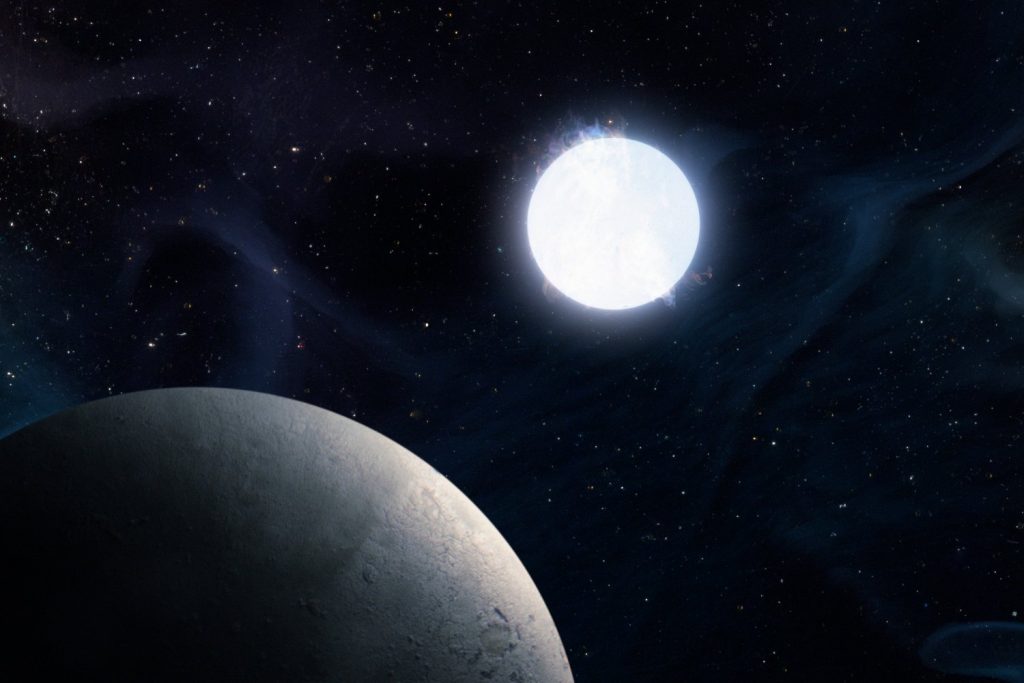
Earth Might Escape Annihilation When Our Sun Dies, Study Shows (Image Credit: Gizmodo-com)
In billions of years, when our Sun runs out of fuel, it will expand outwards, swallowing up the planets closest to it. While life on Earth will likely be SOL eons before this occurs, the planet itself may endure, according to recent observations of a rocky planet that appears to have survived the death of its own host star.
Indeed, this situation appears to have played out some 4,000 light-years from here. Astronomers used an unusual bending of distant light to discover a star system where things have gone awry, yet an Earth-like planet has somehow managed to survive.
The discovery was made thanks to a quirk of physics called microlensing, in which the gravity of gigantic celestial objects bends light in a way that can magnify it. In this case, the star system passed in front of another star, magnifying its light. When UC Berkeley astronomers took a closer look, the peak of the lensing had passed, and the star’s light had faded. But as they observed the star system, the bright light of the background star had been replaced by darkness. The only conclusion they could reach was that this object, which was massive enough to magnify light with its gravity but cast little light of its own, was a white dwarf—the remnant core of a once-larger star that has exhausted its nuclear fuel.
Despite the darkness, the astronomers were still able to determine that the white dwarf was orbited by two objects: a brown dwarf (an object larger than a gas giant planet, but smaller than a star) and and a terrestrial (rocky) exoplanet that’s around 20% bigger than Earth.
The latter could be a glimpse into our own planet’s future, the astronomers noted in their study, published in Nature Astronomy. In about 6 billion years from now, our Sun is predicted to run out of the hydrogen fuel in its core. As the nuclear fusion process slows, the Sun’s core will contract and heat up. Instead of hydrogen isotopes fusing into helium, the helium will fuse into heavier elements like carbon, oxygen, and nitrogen, and the dying star will expand.
Mars, the fourth planet from the Sun, will likely survive this catastrophe, they wrote, but Earth’s final fate “remains uncertain.” Depending on how big the red giant grows, Earth may find itself sharing the fate of Venus and Mercury—getting swallowed up and annihilated. Or, like its recently discovered doppelganger, Earth may be far enough away to survive.
The good news, according to Keming Zhang, a postdoctoral fellow at UC San Diego, who led the research during his time at UC Berkeley, is that everything on Earth will be dead far before then.
“In any case, planet Earth will only be habitable for around another billion years, at which point Earth’s oceans would be vaporized by runaway greenhouse effect—long before the risk of getting swallowed by the red giant,” he said in a statement. To be clear, he’s referring to a naturally occurring warming due to the Sun’s advanced age, not a greenhouse effect caused by human activity.
The two planets orbiting this white dwarf are just the latest evidence that a star’s death doesn’t necessarily spell doom for its orbiting planets. In June, another paper described a plucky gas planet, somewhere between Neptune and Saturn in size, that seems to be doing just fine, despite being in close orbit around a red giant (albeit, with surface temperatures hot enough to melt steel).
If this best case scenario does play out, don’t raise your hopes that life will spontaneously spring up once more on Earth. The dramatic changes to the solar system would result in Earth’s orbit taking it further away from the Sun than Mars, outside the habitable zone where liquid water can exist, according to the researchers.
Still, Zhang chose to look at the bright side. The Sun’s expansion may make Earth a blighted, frigid wasteland, but it will have a delightful effect on the moons around Jupiter and Saturn, some of which have frozen water. These moons could theoretically become habitable during the Sun’s red dwarf phase, and, if humanity still exists, it could find refuge on them, he said. So we’ve got that going for us, which is nice. I think.





